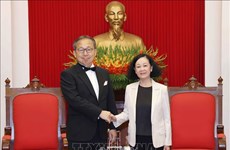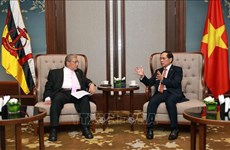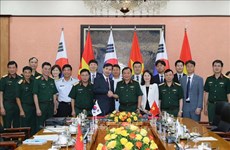VN’s contributions to ASEAN Economic Community
Vietnam not only participates in establishing the ASEAN Economic
Community (AEC) as a member nation but also plays a leading role in
ASEAN’s cooperation process.
Vietnam not only participates in establishing the ASEAN Economic
Community (AEC) as a member nation but also plays a leading role in
ASEAN’s cooperation process, said Vietnamese Minister of Industry and
Trade (MoIT) Vu Huy Hoang.
In his article entitled “Vietnam’s participation and contributions to the ASEAN Economic Community” to mark the 15 th anniversary of Vietnam’s admission to ASEAN (July 28, 1995-2010), Hoang said that Vietnam, as the incumbent ASEAN Chair, makes AEC one of the important contents on the ASEAN agenda in 2010.
The new year message of Vietnam as it assumed the Chair of the AEC Conference, stressed that Vietnam and ASEAN would focus on the implementation of the AEC roadmap by 2015.
“This is a great objective that decides the existence of ASEAN as a united economic entity and a driving force of the process of regional economic linkage,” the minister said.
In demonstrating its ASEAN Chair role, Vietnam has set an example in implementing AEC commitments in a proactive and constructive manner.
By 2010, Vietnam has reduced import tariffs to 0-5 percent for nearly 10,000 product lines under CEPT/AFTA or 97.8 percent of the total tariff lines, including 5,488 tariff lines of 0 percent.
The country has also boosted comprehensive cooperation with other ASEAN members in both traditional fields such as goods trading, service, investment, agriculture, transport and telecommunications and new areas, including intellectual property, competitive policies and consumer protection.
ASEAN is aspiring to build a united, dynamic and prosperous community by 2015, which bases on three main pillars: the AEC, the ASEAN Political-Security Community and the ASEAN Socio-Cultural Community.
At the 7th ASEAN Summit held in Cebu, the Philippines , in January 2007, ASEAN leaders approved the building of an Overall Plan and Strategic Roadmap for the AEC with specific measures and a complete enforcement mechanism. They also decided to move up the target date of completing the AEC to 2015 instead of 2020 as initially agreed in 2004. This was considered the bloc’s most important milestone since 2002 when ASEAN basically completed its Joint Effective Preferential Tariff to implement the ASEAN Free Trade Area (CEPT/AFTA).
After 2010, the AEC is envisioned to be a common market and a uniform production space. The market will play up ASEAN’s overall advantages to gradually build it into a dynamic and highly-competitive region in the world, bringing in prosperity to all ASEAN people and nations.
At the 16th ASEAN Summit in Hanoi , which was chaired by Vietnam , ASEAN leaders issued a Joint Statement on Sustainable Recovery and Development which stresses a determination to consolidate and building the AEC in 2015.
For the first time, ASEAN put forth a model of AEC development based on the harmonisation of socio-economic and environmental policies and macroeconomic management policies.
The AEC will create a framework for close cooperation and balanced development among the ASEAN, Hoang said, adding that the establishment of the AEC is also a big opportunity for Vietnam .
ASEAN is an important door to the world for Vietnam and the AEC will help the Vietnamese economy establish its firm position in the region’s common production structure, he stressed.
The minister noted that 2010 has so far seen many milestones set in the implementation of the AEC objective. As from January, up to 99 percent of the total tariff lines have been removed in intra-bloc trade. The average tariff has reduced to 0.9 percent in 2009 from 4.4 percent in 2000.
The implementation of trade liberalisation commitments on 12 priority sectors during ASEAN’s integration process, including garment, rubber, footwear, auto industry, agriculture, seafood, information technology and tourism has entered the final stage.
On May 1, 2010, the ASEAN Trade in Goods Agreement (ATIGA) took effect after eight months of delay, replacing the former CEPT/AFTA Agreement. The new agreement has timely repaired legal shortcomings and opened up more opportunities for closer cooperation to boost trade facilitation programmes.
Many agreement relating to the AEC are also in final reviews before they officially become effective, including the ASEAN Comprehensive Investment Agreement (ACIA), the seventh commitment package of the ASEAN Framework Agreement on Services, the ASEAN Multilateral Agreement on the Full Liberalisation of Air Freight Services and the ASEAN Agreement on the Facilitation of Goods in Transit.
Two-way trade between Vietnam and ASEAN tripled to nearly 30 billion USD in 2008 compared to the 2002 figure, accounting for 21 percent of the country’s total import-export turnover.
Also in the period, Vietnam’s export to ASEAN registered an average yearly growth of 28.4 percent from 2.9 billion USD in 2003 to 8.9 billion USD last year, and imports, 27 percent.
ASEAN is one of Vietnam’s largest foreign direct investment (FDI) providers. Malaysia leads regional countries in FDI in Vietnam with 18 billion USD, followed by Singapore with over 16 billion USD, Thailand with 5.6 billion USD and Brunei with 4.6 billion USD./.
In his article entitled “Vietnam’s participation and contributions to the ASEAN Economic Community” to mark the 15 th anniversary of Vietnam’s admission to ASEAN (July 28, 1995-2010), Hoang said that Vietnam, as the incumbent ASEAN Chair, makes AEC one of the important contents on the ASEAN agenda in 2010.
The new year message of Vietnam as it assumed the Chair of the AEC Conference, stressed that Vietnam and ASEAN would focus on the implementation of the AEC roadmap by 2015.
“This is a great objective that decides the existence of ASEAN as a united economic entity and a driving force of the process of regional economic linkage,” the minister said.
In demonstrating its ASEAN Chair role, Vietnam has set an example in implementing AEC commitments in a proactive and constructive manner.
By 2010, Vietnam has reduced import tariffs to 0-5 percent for nearly 10,000 product lines under CEPT/AFTA or 97.8 percent of the total tariff lines, including 5,488 tariff lines of 0 percent.
The country has also boosted comprehensive cooperation with other ASEAN members in both traditional fields such as goods trading, service, investment, agriculture, transport and telecommunications and new areas, including intellectual property, competitive policies and consumer protection.
ASEAN is aspiring to build a united, dynamic and prosperous community by 2015, which bases on three main pillars: the AEC, the ASEAN Political-Security Community and the ASEAN Socio-Cultural Community.
At the 7th ASEAN Summit held in Cebu, the Philippines , in January 2007, ASEAN leaders approved the building of an Overall Plan and Strategic Roadmap for the AEC with specific measures and a complete enforcement mechanism. They also decided to move up the target date of completing the AEC to 2015 instead of 2020 as initially agreed in 2004. This was considered the bloc’s most important milestone since 2002 when ASEAN basically completed its Joint Effective Preferential Tariff to implement the ASEAN Free Trade Area (CEPT/AFTA).
After 2010, the AEC is envisioned to be a common market and a uniform production space. The market will play up ASEAN’s overall advantages to gradually build it into a dynamic and highly-competitive region in the world, bringing in prosperity to all ASEAN people and nations.
At the 16th ASEAN Summit in Hanoi , which was chaired by Vietnam , ASEAN leaders issued a Joint Statement on Sustainable Recovery and Development which stresses a determination to consolidate and building the AEC in 2015.
For the first time, ASEAN put forth a model of AEC development based on the harmonisation of socio-economic and environmental policies and macroeconomic management policies.
The AEC will create a framework for close cooperation and balanced development among the ASEAN, Hoang said, adding that the establishment of the AEC is also a big opportunity for Vietnam .
ASEAN is an important door to the world for Vietnam and the AEC will help the Vietnamese economy establish its firm position in the region’s common production structure, he stressed.
The minister noted that 2010 has so far seen many milestones set in the implementation of the AEC objective. As from January, up to 99 percent of the total tariff lines have been removed in intra-bloc trade. The average tariff has reduced to 0.9 percent in 2009 from 4.4 percent in 2000.
The implementation of trade liberalisation commitments on 12 priority sectors during ASEAN’s integration process, including garment, rubber, footwear, auto industry, agriculture, seafood, information technology and tourism has entered the final stage.
On May 1, 2010, the ASEAN Trade in Goods Agreement (ATIGA) took effect after eight months of delay, replacing the former CEPT/AFTA Agreement. The new agreement has timely repaired legal shortcomings and opened up more opportunities for closer cooperation to boost trade facilitation programmes.
Many agreement relating to the AEC are also in final reviews before they officially become effective, including the ASEAN Comprehensive Investment Agreement (ACIA), the seventh commitment package of the ASEAN Framework Agreement on Services, the ASEAN Multilateral Agreement on the Full Liberalisation of Air Freight Services and the ASEAN Agreement on the Facilitation of Goods in Transit.
Two-way trade between Vietnam and ASEAN tripled to nearly 30 billion USD in 2008 compared to the 2002 figure, accounting for 21 percent of the country’s total import-export turnover.
Also in the period, Vietnam’s export to ASEAN registered an average yearly growth of 28.4 percent from 2.9 billion USD in 2003 to 8.9 billion USD last year, and imports, 27 percent.
ASEAN is one of Vietnam’s largest foreign direct investment (FDI) providers. Malaysia leads regional countries in FDI in Vietnam with 18 billion USD, followed by Singapore with over 16 billion USD, Thailand with 5.6 billion USD and Brunei with 4.6 billion USD./.













